Jared Diamond - Guns, Germs & Steel
Здесь есть возможность читать онлайн «Jared Diamond - Guns, Germs & Steel» весь текст электронной книги совершенно бесплатно (целиком полную версию без сокращений). В некоторых случаях можно слушать аудио, скачать через торрент в формате fb2 и присутствует краткое содержание. Жанр: 105. Описание произведения, (предисловие) а так же отзывы посетителей доступны на портале библиотеки ЛибКат.
- Название:Guns, Germs & Steel
- Автор:
- Жанр:
- Год:неизвестен
- ISBN:нет данных
- Рейтинг книги:5 / 5. Голосов: 1
-
Избранное:Добавить в избранное
- Отзывы:
-
Ваша оценка:
- 100
- 1
- 2
- 3
- 4
- 5
Guns, Germs & Steel: краткое содержание, описание и аннотация
Предлагаем к чтению аннотацию, описание, краткое содержание или предисловие (зависит от того, что написал сам автор книги «Guns, Germs & Steel»). Если вы не нашли необходимую информацию о книге — напишите в комментариях, мы постараемся отыскать её.
Guns, Germs & Steel — читать онлайн бесплатно полную книгу (весь текст) целиком
Ниже представлен текст книги, разбитый по страницам. Система сохранения места последней прочитанной страницы, позволяет с удобством читать онлайн бесплатно книгу «Guns, Germs & Steel», без необходимости каждый раз заново искать на чём Вы остановились. Поставьте закладку, и сможете в любой момент перейти на страницу, на которой закончили чтение.
Интервал:
Закладка:
FARMER POWER • 91
ing our main means of land transport until the development of railroads in the 19th century. Before animal domestication, the sole means of transporting goods and people by land was on the backs of humans. Large mammals changed that: for the first time in human history, it became possible to move heavy goods in large quantities, as well as people, rapidly overland for long distances. The domestic animals that were ridden were the horse, donkey, yak, reindeer, and Arabian and Bactrian camels. Animals of those same five species, as well as the llama, were used to bear packsCows and horses were hitched to wagons, while reindeer and dogs pulled sleds in the Arctic. The horse became the chief means of long-distance transport over most of Eurasia. The three domestic camel species (Arabian camel, Bactrian camel, and llama) played a similar role in areas of North Africa and Arabia, Central Asia, and the Andes, respectively.
The most direct contribution of plant and animal domestication to wars of conquest was from Eurasia's horses, whose military role made them the jeeps and Sherman tanks of ancient warfare on that continent. As I mentioned in Chapter 3, they enabled Cortes and Pizarro, leading only small bands of adventurers, to overthrow the Aztec and Inca Empires. Even much earlier (around 4000 b.c.), at a time when horses were still ridden bareback, they may have been the essential military ingredient behind the westward expansion of speakers of Indo-European languages from the Ukraine. Those languages eventually replaced all earlier western European languages except Basque. When horses later were yoked to wagons and other vehicles, horse-drawn battle chariots (invented around 1800 b.c.) proceeded to revolutionize warfare in the Near East, the Mediterranean region, and China. For example, in 1674 b.c., horses even enabled a foreign people, the Hyksos, to conquer then horseless Egypt and to establish themselves temporarily as pharaohs.
Still later, after the invention of saddles and stirrups, horses allowed the Huns and successive waves of other peoples from the Asian steppes to terrorize the Roman Empire and its successor states, culminating in the Mongol conquests of much of Asia and Russia in the 13th and 14th centuries a.d. Only with the introduction of trucks and tanks in World War I did horses finally become supplanted as the main assault vehicle and means of fast transport in war. Arabian and Bactrian camels played a similar military role within their geographic range. In all these examples, peoples with domestic horses (or camels), or with improved means of using them, enjoyed an enormous military advantage over those without them.
92. • GUNS, GERMS,and steel
Of equal importance in wars of conquest were the germs that evolved in human societies with domestic animals. Infectious diseases like smallpox, measles, and flu arose as specialized germs of humans, derived by mutations of very similar ancestral germs that had infected animals (Chapter 11). The humans who domesticated animals were the first to fall victim to the newly evolved germs, but those humans then evolved substantial resistance to the new diseases. When such partly immune people came into contact with others who had had no previous exposure to the germs, epidemics resulted in which up to 99 percent of the previously unexposed population was killed. Germs thus acquired ultimately from domestic animals played decisive roles in the European conquests of Native Americans, Australians, South Africans, and Pacific islanders.
In short, plant and animal domestication meant much more food and hence much denser human populations. The resulting food surpluses, and (in some areas) the animal-based means of transporting those surpluses, were a prerequisite for the development of settled, politically centralized, socially stratified, economically complex, technologically innovative societies. Hence the availability of domestic plants and animals ultimately explains why empires, literacy, and steel weapons developed earliest in Eurasia and later, or not at all, on other continents. The military uses of horses and camels, and the killing power of animal-derived germs, complete the list of major links between food production and conquest that we shall be exploring.
CHAPTER 5
history's haves and have-nots
MUCH OF HUMAN HISTORY HAS CONSISTED OF UNEQUAL conflicts between the haves and the have-nots: between peoples with farmer power and those without it, or between those who acquired it at different times. It should come as no surprise that food production never arose in large areas of the globe, for ecological reasons that still make it difficult or impossible there today. For instance, neither farming nor herding developed in prehistoric times in North America's Arctic, while the sole element of food production to arise in Eurasia's Arctic was reindeer herding. Nor could food production spring up spontaneously in deserts remote from sources of water for irrigation, such as central Australia and parts of the western United States.
Instead, what cries out for explanation is the failure of food production to appear, until modern times, in some ecologically very suitable areas that are among the world's richest centers of agriculture and herding today. Foremost among these puzzling areas, where indigenous peoples were still hunter-gatherers when European colonists arrived, were California and the other Pacific states of the United States, the Argentine pampas, southwestern and southeastern Australia, and much of the Cape region of South Africa. Had we surveyed the world in 4000 b.c., thousands of years after the rise of food production in its oldest sites of origin, we would have been
94 * GUNS, GERMS, AND STEEL
surprised too at several other modern breadbaskets that were still then without it—including all the rest of the United States, England and much of France, Indonesia, and all of subequatorial Africa. When we trace food production back to its beginnings, the earliest sites provide another surprise. Far from being modern breadbaskets, they include areas ranking today as somewhat dry or ecologically degraded: Iraq and Iran, Mexico, the Andes, parts of China, and Africa's Sahel zone. Why did food production develop first in these seemingly rather marginal lands, and only later in today's most fertile farmlands and pastures?
Geographic differences in the means by which food production arose are also puzzling. In a few places it developed independently, as a result of local people domesticating local plants and animals. In most other places it was instead imported, in the form of crops and livestock that had been domesticated elsewhere. Since those areas of nonindependent origins were suitable for prehistoric food production as soon as domesticates had arrived, why did the peoples of those areas not become farmers and herders without outside assistance, by domesticating local plants and animals?
Among those regions where food production did spring up independently, why did the times at which it appeared vary so greatly—for example, thousands of years earlier in eastern Asia than in the eastern United States and never in eastern Australia? Among those regions into which it was imported in the prehistoric era, why did the date of arrival also vary so greatly—for example, thousands of years earlier in southwestern Europe than in the southwestern United States? Again among those regions where it was imported, why in some areas (such as the southwestern United States) did local hunter-gatherers themselves adopt crops and livestock from neighbors and survive as farmers, while in other areas (such as Indonesia and much of subequatorial Africa) the importation of food production involved a cataclysmic replacement of the region's original hunter-gatherers by invading food producers? All these questions involve developments that determined which peoples became history's have-nots, and which became its haves.
Before we can hope to answer these questions, we need to figure out how to identify areas where food production originated, when it arose there, and where and when a given crop or animal was first domesticated. The most unequivocal evidence comes from identification of plant and
Интервал:
Закладка:
Похожие книги на «Guns, Germs & Steel»
Представляем Вашему вниманию похожие книги на «Guns, Germs & Steel» списком для выбора. Мы отобрали схожую по названию и смыслу литературу в надежде предоставить читателям больше вариантов отыскать новые, интересные, ещё непрочитанные произведения.
Обсуждение, отзывы о книге «Guns, Germs & Steel» и просто собственные мнения читателей. Оставьте ваши комментарии, напишите, что Вы думаете о произведении, его смысле или главных героях. Укажите что конкретно понравилось, а что нет, и почему Вы так считаете.










